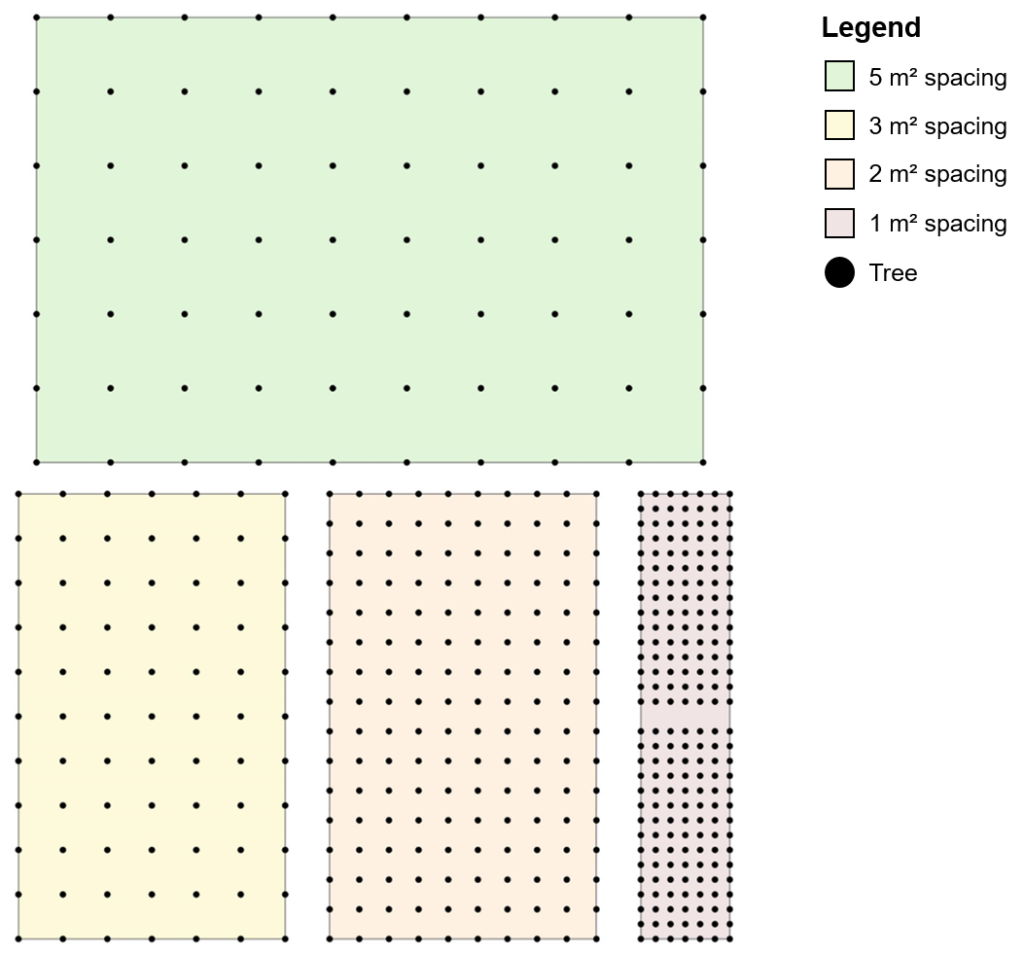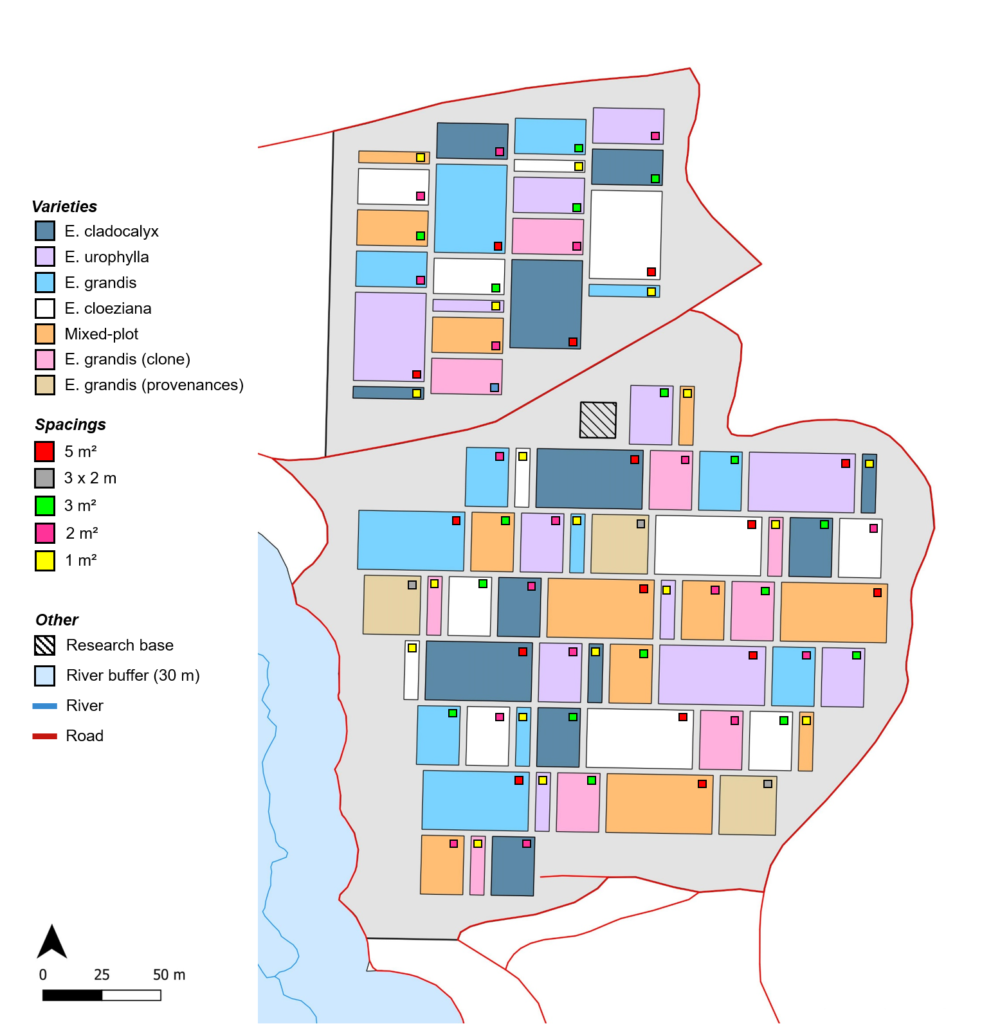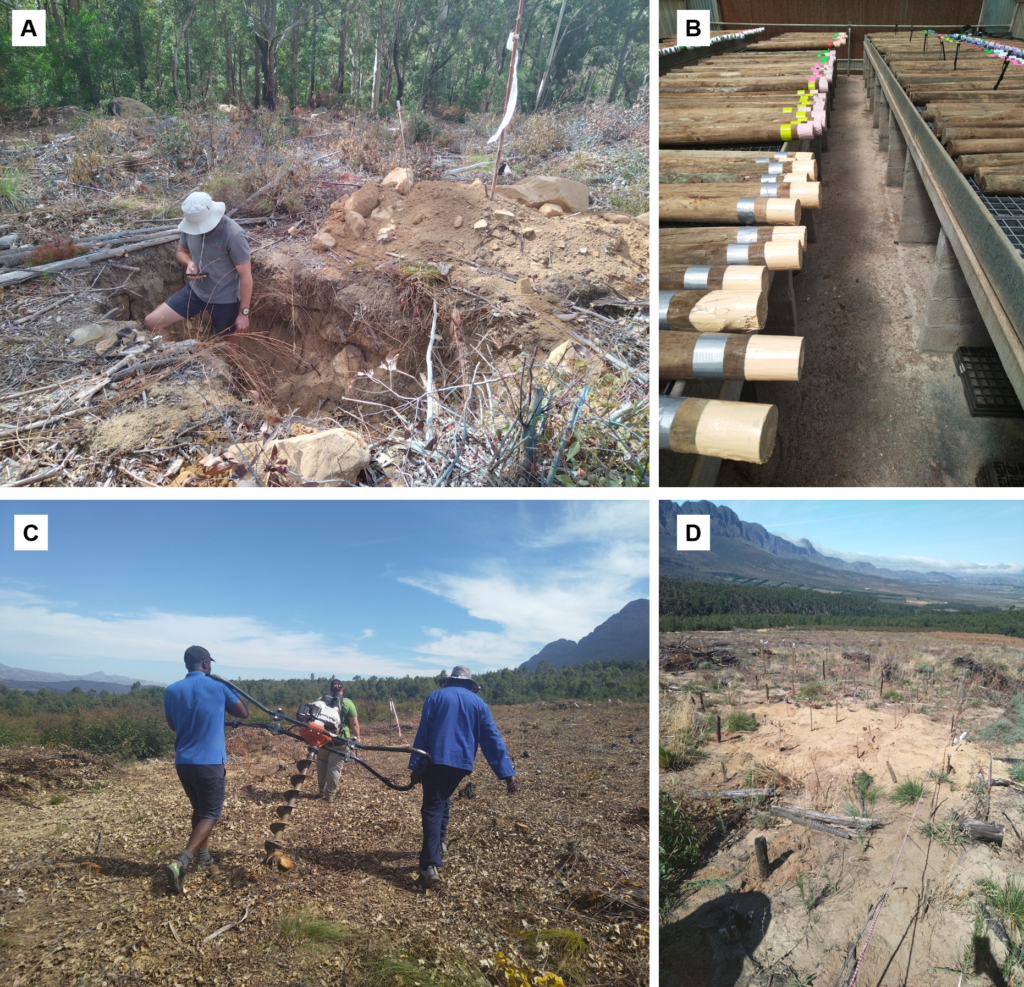
The Hans Merensky Chair in Measuring and Modelling Eucalypt Growth & Wood Formation
Understanding growth in the world's most widely planted hardwoods
The IMPACT Open-Air Lab
What is IMPACT OAL?
The IMPACT OAL (Intensive Monitoring of Planted And Competing Trees Open Air Laboratory) is a state-of-the-art, flagship research plantation. The idea behind IMPACT OAL is to build on the knowledge that we gained from the small- to medium-scale experimental studies performed in phase one of EucXylo, by now examining how Eucalyptus responds to the environment, as well as abiotic and biotic stress, at a large-scale through intensive, long-term monitoring.

The main goal of the IMPACT OAL is to monitor the growth and responses of eucalypts (from root to canopy) when planted at different levels of competition using highly specialised equipment and cutting-edge research methodology. This flagship plantation will show-case cutting edge monitoring technology using state-of-the-art sensor systems connected to the Internet of Things (IoT), remote sensing systems and detailed characterisation of site and environmental variables!
Not only is the IMPACT OAL one of the first intensive monitoring programmes on Eucalyptus in South Africa, and the only experiment of its kind at this scale in the country, it is also showcases sustainable, productive and responsible forest plantation management.
In the spirit of Dr. Merensky, the IMPACT OAL is wide-open for collaboration between researchers from different research sectors and disciplines!
Location of the IMPACT OAL research site
The plantation consists of an area of about 9 hectares that has for many decades been planted with Eucalyptus or Pinus on the greater Lourensford Wine Estate, near Somerset-West (click here to view the location of the plantation). We are grateful to the owners and managers at Lourensford for supporting this new research initiative.
Selected varieties
At the IMPACT OAL seedlings of four varieties, i.e. Eucalyptus cladocalyx, E. cloeziana, E. grandis and E. urophylla have been planted as single-species, as typically practiced in the forestry industry. In addition, we have included a mixed-species “treatment” consisting of E. cloeziana, E. grandis and E. urophylla planted together. Additionally, we will examine a commercial clone of E. grandis that was used in several research projects in phase one of EucXylo.
Significance of selected varieties:
- Eucalyptus cladocalyx – Commonly known as “sugar gum”, it is often used as a windbreak or shelterbelt, but also has significance for timber and firewood production. The flowers of this tree are also very attractive to bees and it is a significant species in the Western Cape for pollination and honey production. The Australian distribution of cladocalyx lies in southern South Australia, and it is one of the most drought tolerant of the larger eucalypts.
- Eucalyptus cloeziana – Commonly known as “Gympie messmate”. The good physical properties of the timber, combined with its high durability, renders it suitable for a wide range of purposes, including heavy construction, sleepers and mining timber. Due to this tree’s straight and branch free stem, the wood can be made into a high-quality transmission pole. It has a scattered natural distribution in tropical and sub-tropical areas. It is also distinct from other species used at IMPACT OAL, being in the subgenus Idiogenes. It has low cold tolerance, but high wind tolerance.
- Eucalyptus grandis – Commonly known as “Flooded gum”, it is an attractive, straight-trunked tree in great demand for its timber or pulp. Its timber is commonly used for flooring, panelling and plywood. This species is appropriate for sub-tropical zones, even humid to sub-humid conditions, but is not suited for areas where frost and snow occur. Although grandis grows better under well-watered conditions, they do show tolerance strategies under drought stress. It has also become what may be called the “model eucalypt”, being the first to have its genome sequenced in 2014, and is widely researched. It is widely grown around the world as a pure species or as a parent in hybrids.
- Eucalyptus urophylla – Commonly known as “Timor white gum” is native to Indonesia. It is used to make a variety of products. This includes pulp, paper, charcoal, poles, posts, panels and furniture. This species has a high tolerance for diseases (e.g. fungal diseases such as Crysoporthe austroafricana and the Coniothyrium cankers). This species shows moderate tolerance to drought stress.
Contrasting levels of competition
Understanding how these different species respond to developing levels of environmental and physiological stress is a core goal of the research at IMPACT OAL. This has been approached by planting the trees at very different spacing intensities to subject them to different levels of competition. At the IMPACT OAL, there are four spacings for the single-species (i.e. E. cladocalyx, E. cloeziana, E. grandis and E. urophylla) seedling plots: 1 m2, 2 m2, 3 m2 and 5 m2 simulating a stand density of 10 000, 2 500, 1 111 and 400 trees per ha, respectively. As for the E. grandis clone, the same spacings are used, but the 5 m2 spacing is excluded. All plots are replicated three times and randomised by spacing and varieties.


The establishment of the IMPACT OAL
After months of planning, the establishment of the IMPACT OAL was started on the 6th of March 2024. The core team at the beginning of establishment consisted of Prof. David Drew, Dr. Leandra Moller-Hanekom and Dr. Michelle Eckert.

Below are some of pictures showing the progress made during the establishment of the IMPACT OAL:

Specialized equipment used at IMPACT OAL
Intensively monitoring the trees across such a large area, with so many plots, is no mean feat! We have opted to go with wireless technologies as far as possible at the IMPACT OAL to minimise cables and make deployment and data acquisition as efficient as we can.
These instruments will be logging data from every 5 minutes to every day!
Weather data will be constantly logged at the site with an automatic weather station that will measure rainfall, wind speed and direction, temperature, incoming solar radiation and barometric pressure. For continuous monitoring of stem size, a new wireless dendrometer has been developed which includes a soil water content/temperature sensor as well as an air temperature and humidity sensor. This means these dendrometers can be deployed with information about both water supply and demand, an important part of our planned analyses. These dendrometers will be deployed in all plots. We will also install sap flow sensors in a subset of plots. We will be using both heat balance-type systems (in particular, Dynamax Dynagage sensors) as well as heat ratio-type systems (in particular, Plant Pulse sensors). Soil water content and temperature through the profile will be logged with Sentek Drill-and-drop probes to depths of 90 cm across two or three transects at the site. Data will be bolstered by several Campbell Scientific 650 probes at varying depths at selected plots. A set of soil rhizotrons are being developing to monitor root development on a weekly basis in all plots.
In addition to the sensors which will be deployed at the site, and constantly returning data, other measurements will be made on a regular basis using several techniques and instruments. These include:
- LiDAR and multispectral drones for aerial imagery of trees and landscape
- Riegl VZ400i Terrestrial Laser Scanner
- LI-COR LI-600F porometer/fluorometer for monitoring fluorescence and stomatal conductance.
- LI-COR 6400 to obtain calibration data and light/carbon dioxide response information.
- Trephor corer for tree core collection to perform xylogenesis analyses.
Acknowledgements
First and foremost, we would like to acknowledge and thank the Hans Merensky Legacy Foundation (HMLF) for their continued collaboration, support and funding!
There are several members from the Department of Forestry and Wood Science, who have made valuable contributions to the establishment of the IMPACT OAL. We’d like to acknowledge the following people for their contributions:
- Deon Malherbe for supervising the site management and assisting with the plot marking phase
- Tertius Venter for assisting with the plot marking phase and technical assistance
- Our students, Ms. Erin Ramsey, Ms. Yasmin de Raay and Mr. Oluwaseun Gakenou, for their assistance during the pole planting phase
- Richard Carkeek and Mr. Martin Vollmer for assistance during the pitting phase
- Ben du Toit for sharing his knowledge on soil nutrient dynamics
- Bruce Talbot for sharing his knowledge on road maintenance
- Wilmour Hendrikse for technical assistance
- Anton Kunneke for technical assistance
Additionally, the establishment of the IMPACT OAL could not be possible without the assistance of:
- Lourensford Wine Estate
- Cape Forestry Timbers
- Agrimotion
- Hansen Gardening and Services